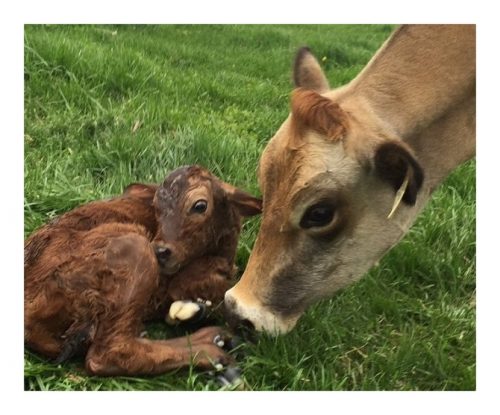CDCB is launching genetic evaluations for another new trait in April – Early First Calving (EFC). You might ask Why, when there are already genetic evaluations for 45 traits. The answer is quite simple: maximum genetic gains can only be achieved when all traits of economic value are included in a composite economic index. Read more from the December 2018 CDCB Connection.
 Raising replacement dairy animals requires upfront financial demands for feed, health care, housing and labor, and normally without any income for a considerable time. Heifer rearing accounts for 15 to 20% of the total cost of producing milk. This has stimulated considerable interest in uncovering the optimum age at first calving. As management practices have improved, one result is a remarkable reduction in age at first calving overall. In 1985 Holsteins averaged 28.1 months, by 2000 averaged 26.0 months and today’s average is 24.5 months.
Raising replacement dairy animals requires upfront financial demands for feed, health care, housing and labor, and normally without any income for a considerable time. Heifer rearing accounts for 15 to 20% of the total cost of producing milk. This has stimulated considerable interest in uncovering the optimum age at first calving. As management practices have improved, one result is a remarkable reduction in age at first calving overall. In 1985 Holsteins averaged 28.1 months, by 2000 averaged 26.0 months and today’s average is 24.5 months.
With rearing cost estimated at about $2.50 per day, the average expense per heifer has reduced by $275 ($2.50 x 110 days). In the typical DHI herd of 277 milking cows, this comes to a cost reduction of $76,000. The remainder of the equation is how the differences in age at first calving affects individual cow’s income once in the milking herd.
We’re fortunate that accurate records for age at calving have been recorded for all cows in DHI for decades. It’s terrific when one finds a trait with economic value that is already being collected (for producers’ benefit) so it doesn’t require a new initiative to capture the data. We’re taking advantage of the “low-hanging fruit” with the introduction of Early First Calving.
Early First Calving Early First Calving (EFC) is defined in days, and it is simply age at first calving with the sign reversed (+ vs. -). Selection toward positive values has been well-accepted for evaluation traits, and the trait was reversed so that selection would be toward what is normally considered the more desirable direction. If a bull transmits the genetics expected to reduce first calving by 2 days, his PTA for Early First Calving would be +2.0 days.
Breeds often differ considerably in age at first calving. Most reports show Jersey enter the milking herd earlier than other breeds, while Ayrshires usually enter at the oldest age. It appears these differences are genetic, based on comparing those heifers born together in the same herd. The national cooperator database showed Jersey contemporaries calving 4 days earlier than Holsteins, whereas the other breeds calved later than Holsteins; Milking Shorthorn by 15 days, Guernseys by 18 days, Brown Swiss by 28 days and Ayrshires by 41 days. Genetic trend toward earlier calving already have shown about a 10-day gain toward younger calving in Holsteins and Jerseys, and as much as a 1 to 2-day gain in just the last 5 years.
Let’s review some details about the new Early First Calving evaluation. The following effects were accounted for in the model: herd-year-season of birth, regressions on inbreeding and heterosis, and animal genetic effect. The heritability of Early First Calving was 2.3%. The standard deviation of PTA (within breed) was 3 days, but a few recent bulls had deviations as large as 10 days. The new trait is grouped together with the fertility traits of heifer conception rate, cow conception rate and daughter pregnancy rate to (conveniently) facilitate multi-trait methods in the future. Reliabilities for young genotyped Holsteins averaged 66% and Jerseys averaged 51%. This is one of the amazing benefits of genotyping … one receives high prediction accuracy even though the heritability estimate for the trait is low.
Written by: H. Duane Norman & Jana Hutchison
